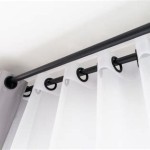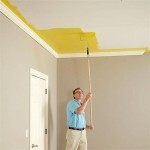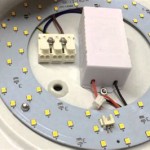How To Hang Acrylic Sheet From Ceiling Walls
Acrylic sheets, also known as plexiglass or Perspex, offer a versatile and aesthetically pleasing alternative to glass in various applications, including signage, displays, protective barriers, and architectural elements. When considering the installation of acrylic sheets suspended from ceilings or attached to walls, a careful approach that considers material properties, safety, and desired aesthetic is crucial. This article provides a comprehensive guide on how to securely and effectively hang acrylic sheets, addressing pertinent factors and offering practical strategies for successful installation. Specific methods depend on the size, thickness, and intended use of the acrylic sheet, as well as the construction of the mounting surface.
Prior to commencing any installation, a thorough assessment of the project requirements is essential. This includes determining the dimensions and weight of the acrylic sheet, evaluating the structural integrity of the ceiling or wall from which it will be suspended, and identifying any existing utilities or obstructions that may impact the installation process. It is also important to comply with any local building codes or regulations pertaining to the installation of such materials, ensuring that all safety standards are met. Furthermore, the selection of appropriate hanging hardware and tools is paramount. The hardware must be capable of supporting the weight of the acrylic sheet with a suitable safety margin and be compatible with both the acrylic material and the mounting surface.
Key Point 1: Selecting Appropriate Hanging Hardware and Tools
The choice of hanging hardware is a critical factor in ensuring the stability and longevity of the acrylic sheet installation. The selection process involves considering several variables, including the weight and thickness of the acrylic sheet, the type of ceiling or wall construction, and the desired aesthetic. Commonly used hardware options are standoffs, suspension cables, edge grips, and screw-in fasteners, each offering distinct advantages and limitations.
Standoffs, typically made of metal or plastic, provide a clean and contemporary appearance by creating a space between the acrylic sheet and the mounting surface. They are attached to the acrylic sheet using screws or adhesive, and then secured to the wall or ceiling with appropriate anchors. The selection of standoff size and material should be based on the weight and thickness of the acrylic sheet, as well as the aesthetic preference. Ensure the selected standoffs are designed for use with acrylic and that the mounting screws are not overtightened, as this can cause cracking or crazing in the acrylic.
Suspension cables offer a more minimalist and flexible approach, particularly suitable for hanging acrylic sheets from ceilings. They consist of a cable, a cable clamp, and a ceiling mount. The cable is attached to the acrylic sheet using a specialized clamp or fastener, and then suspended from the ceiling mount. The length of the cable can be adjusted to achieve the desired height. It is crucial to use cables with a sufficient load rating to support the weight of the acrylic sheet, ensuring a significant safety margin. The ceiling mount should be securely anchored to the ceiling structure, using appropriate fasteners for the ceiling material, such as concrete anchors for concrete ceilings or wood screws for wood framing.
Edge grips provide a secure and inconspicuous method of attaching acrylic sheets to walls or other surfaces. They consist of a metal or plastic clamp that grips the edge of the acrylic sheet, distributing the load evenly. Edge grips are typically used for applications where a flush or near-flush mounting is desired. The selection of edge grip size and material should be based on the thickness of the acrylic sheet and the load requirements. Ensure that the edge grips are properly aligned and secured to the mounting surface, using appropriate fasteners.
Screw-in fasteners, such as screws or bolts, can be used for direct attachment of acrylic sheets to walls or ceilings. However, this method requires careful execution to avoid cracking or damaging the acrylic material. When using screw-in fasteners, it is essential to pre-drill holes in the acrylic sheet that are slightly larger than the diameter of the screw. This allows the acrylic to expand and contract with temperature changes without putting stress on the fasteners. Washers should also be used to distribute the load and prevent the screw head from digging into the acrylic. The screws should be tightened carefully, avoiding overtightening, which can cause cracking or crazing.
In addition to the hanging hardware, specific tools are needed for the installation of acrylic sheets. These tools include a drill with appropriate drill bits for acrylic and the mounting surface, a level, a measuring tape, a pencil, a screwdriver or wrench, and safety glasses. It is essential to use drill bits specifically designed for acrylic to prevent cracking or chipping. The level ensures that the acrylic sheet is hung straight, and the measuring tape and pencil are used for accurate placement of the hardware. Safety glasses protect the eyes from debris during drilling and installation.
Key Point 2: Preparing the Acrylic Sheet for Hanging
Proper preparation of the acrylic sheet is paramount for a successful and aesthetically pleasing installation. This involves cleaning the sheet, drilling holes (if required), and protecting the edges to prevent damage. A clean surface ensures optimal adhesion for any adhesive-based hardware and allows for a clear view of the material.
Before handling the acrylic sheet, it is vital to wear clean gloves to prevent fingerprints and smudges. The surface of the acrylic sheet should be cleaned with a soft, lint-free cloth and a specialized acrylic cleaner. Avoid using harsh chemicals or abrasive cleaners, as these can damage the surface of the acrylic. Gently wipe the surface of the acrylic sheet to remove any dust, dirt, or debris. If there are any stubborn stains or marks, a mild soap and water solution can be used, followed by a thorough rinsing with clean water and drying with a lint-free cloth.
If the mounting method requires drilling holes in the acrylic sheet, it is essential to use the correct drill bit and technique. Use a drill bit specifically designed for acrylic, as these bits have a shallower angle and a sharper point, preventing cracking or chipping. Always pre-drill a pilot hole before drilling the final hole. The pilot hole should be slightly smaller than the diameter of the screw or fastener that will be used. When drilling the final hole, apply gentle pressure and use a slow speed to avoid overheating the acrylic. It is advisable to use a lubricant, such as cutting oil or water, to reduce friction and prevent the acrylic from melting. Support the acrylic sheet firmly during drilling to prevent it from vibrating or shifting. The hole diameter should be slightly larger than the screw to account for expansion and contraction.
The edges of the acrylic sheet are vulnerable to damage during handling and installation. To protect the edges, apply a strip of painter's tape along each edge. The painter's tape will provide a cushion against scratches and chips. Additionally, consider using edge protectors, which are specialized plastic or rubber strips that can be attached to the edges of the acrylic sheet. Edge protectors provide a more robust level of protection, particularly during transportation and installation. Be careful when peeling away the painter's tape, doing it slowly to avoid leaving residue on the acrylic sheet.
Key Point 3: Ensuring Safe and Secure Installation
The installation of acrylic sheets suspended from ceilings or attached to walls requires a safe and methodical approach. Ensuring the stability of the installation is paramount to preventing accidents and protecting the acrylic sheet from damage. Proper planning, accurate measurements, and secure fastening are crucial for a successful outcome.
Before commencing the installation, carefully measure and mark the locations for the hanging hardware on both the acrylic sheet and the mounting surface. Use a level to ensure that the markings are aligned and that the acrylic sheet will be hung straight. Verify the accuracy of the measurements before proceeding with the installation. Improper measurements can lead to misalignment, instability, and potential damage to the acrylic sheet or the mounting surface.
When attaching the hanging hardware to the acrylic sheet, follow the manufacturer's instructions carefully. Avoid overtightening screws or fasteners, as this can cause cracking or crazing in the acrylic material. Use washers to distribute the load and prevent the screw head from digging into the acrylic. If using adhesive-based hardware, ensure that the surfaces are clean and dry before applying the adhesive. Allow the adhesive to cure completely before hanging the acrylic sheet. The curing time will vary depending on the type of adhesive used; refer to the manufacturer's instructions for specific recommendations.
When attaching the hanging hardware to the mounting surface, select appropriate fasteners for the material of the ceiling or wall. Use concrete anchors for concrete ceilings or walls, wood screws for wood framing, and drywall anchors for drywall. Ensure that the fasteners are securely anchored and that they are capable of supporting the weight of the acrylic sheet with a suitable safety margin. Consider the load-bearing capacity of the mounting surface and reinforce it if necessary. For example, if hanging a heavy acrylic sheet from a drywall ceiling, it may be necessary to install additional framing to provide adequate support. Secure all cable clamps and ensure no cable slack exists.
After the acrylic sheet is installed, inspect the installation carefully to ensure that it is secure and stable. Check that all fasteners are tightened and that the acrylic sheet is hanging straight. Gently apply pressure to the acrylic sheet to test its stability. If there is any movement or instability, re-tighten the fasteners or add additional support. Address any issues promptly to prevent accidents or damage to the acrylic sheet. Consider having a qualified professional inspect the installation, especially if it involves complex or heavy acrylic sheets. Regular inspections are crucial to identifying potential weaknesses or wear and tear over time, and ensure the longevity of the installation.
By carefully selecting the appropriate hardware, preparing the acrylic sheet properly, and ensuring a safe and secure installation, the desired aesthetic and functional performance of the acrylic sheet installation can be achieved. Regular maintenance, including cleaning and inspection, will help to prolong the lifespan of the installation and maintain its appearance.

Fastening And Laying Plexiglas

Painting Prep How To Hang Plastic From The Ceiling

How To Install Ceiling Panels The Panel Company

Painting Prep How To Hang Plastic From The Ceiling

Budget Floating Acrylic Frame

Diy 3d Wall Panel Installation

How To Hang Acrylic Prints Wall Art A Comprehensive Installation Guide Bruzzen

5 Ways To Hang Anything From The Ceiling

Acrylic Sheet Kaise Lgate Hai How To Apply On Wall

Plastic Shield Hanging Kit T Bar Suspension Covid 19 Protective
Related Posts








